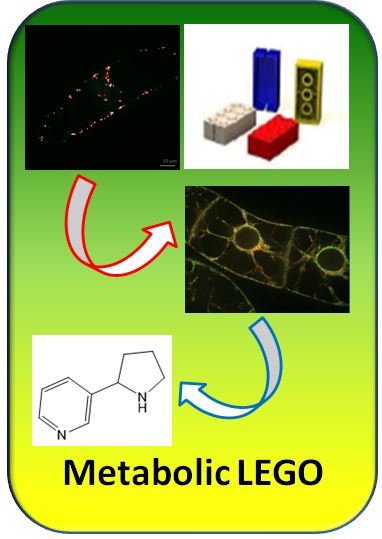2017_02 Metabolic LEGO
What is it about?
Plants can synthetise more than a million of so called secondary compounds. What for? Since they cannot run away, plants have chosen the evolutionary strategy to manipulate other organisms for their purpose. Many of these compounds have there also an effect on humans and represent the molecular base for the healing activity of many plants. Since several years we work on production of these secondary compounds in cell cultures to obtain a sustainable alternatives for the collection and extraction of frequently endangered and rare plants. However, often these compounds are not made in cell culture, because plant chemistry is team work, where different cells have to coopeerate. This "metabolic LEGO" is hard to simulate in a biofermenter. To get a biotechnological copy of celllular cooperation, we have, together with the team of Dr. Andreas Guber (Institute for Microstructure Technology, IMT, Campus Nord) developed a microfluidic biofermenter for plant cells, which is currently tested for the production of pharmaceutical compounds in frame of a project funded by the Ministry of Education and Research.
Modular Metabolics - does this work?
But do we know, whether combination of different cell types is useful? To get a proof-of-principle for this idea, we used alkaloid metabolism of tobacco as case model. The most famous tobacco compound is of course nicotine. Nicotine is produced in the root, when the plant is attacked by caterpillars. It is then transported into the leaves and accumulates there, such that the attacker will get poisened while eating. Some species of tobacco convert the nicotine in the leaves by a Tabakarten wird das Nicotin in den Blättern über eine Nicotine Demethylase into the medically interesting nornicotine. This alkaloid is meanwhile discussed as potent drug against Alzheimer disease (caveat: smoking does not work - during smoking, nornicotine is nitrosylated and not only looses its efficacy, but also turns extremely cancerogenic). To activate alkaloid metabolism in the tobacco cells, we mimicked a caterpillar attack by addition of the wound hormone methyl jasmonate. In fact, these cells began to form alkaloids, but no nicotine was found, but only a side product, anatabine.
We then introduced the gene MPO1 encoding an enyzme essential for an early step in nicotine synthesis. To see, where this enzyme acts, we coupled a DNA sequence for the Green Fluorescent Protein (GFP). We could now observe the green fluorescent MPO1 protein appear in vesicles and by additional fluorescent markers we could demonstrate that these vesicles were so called peroxisomes. In response to the wound signal, these cells produced large amounts of nicotine and also exported this product into the medium. Nornicotine remained elusive, though. We now generated a second cell line, where the Nicotin-Demethylase was introduced, as well in a fluorescent version. This showed us that Nicotin-Demethylase is located in an intracellular network, the Endoplasmic Reticulum. However, we still were not able to detect nornicotine. Even, when these cells were fed with the precursor nicotine, not much was happening.
Our breakthrough came from an experiment, where the Nicotin-Demethylase cells were confronted with medium, were before the MPO1 cells had been growing. Now, suddenly large amounts of nornicotine were produced. By this finding, we had demonstrated that combination of different cell types will release novel metabolic potencies that would not be found in any of these cell types, if kept alone. Thus, Metabolic LEGO is promising. Using the microfluidic biofermenter, we can now test for such synergies in the micro scale, before the best approach is then scaled up for industrial production.
Publication
128. Rajabi F, Heene E, Maisch J, Nick P (2017) Combination of plant metabolic modules yields synthetic synergies. PLoS ONE 12, e0169778 - pdf

